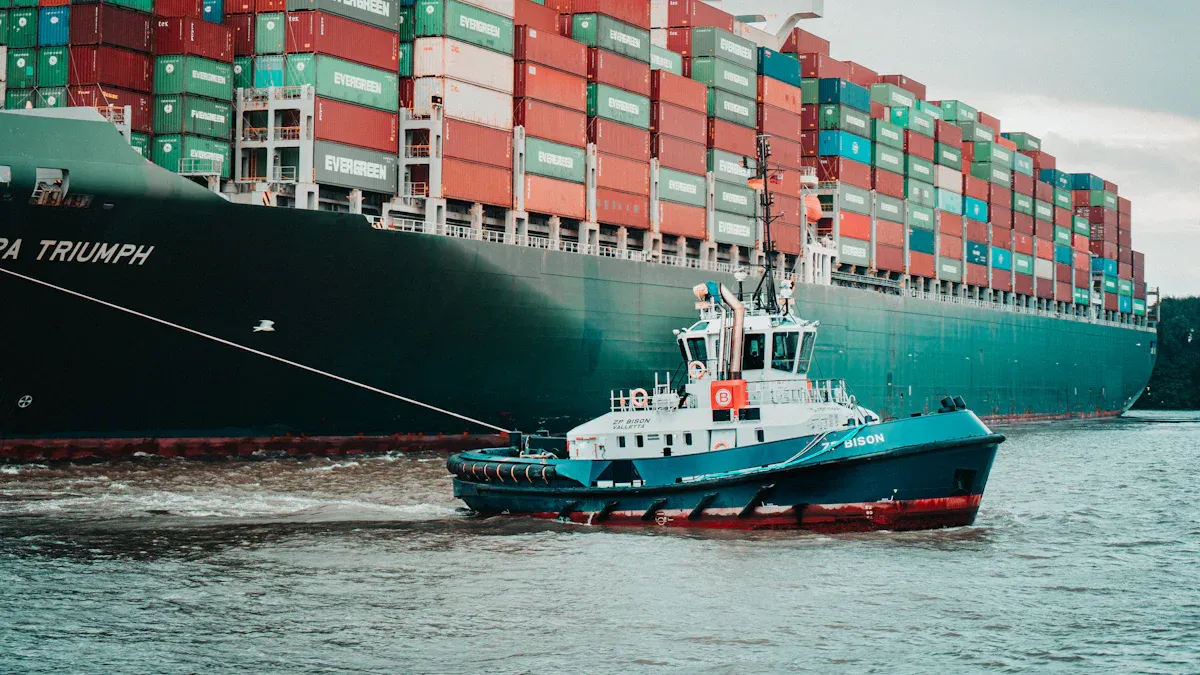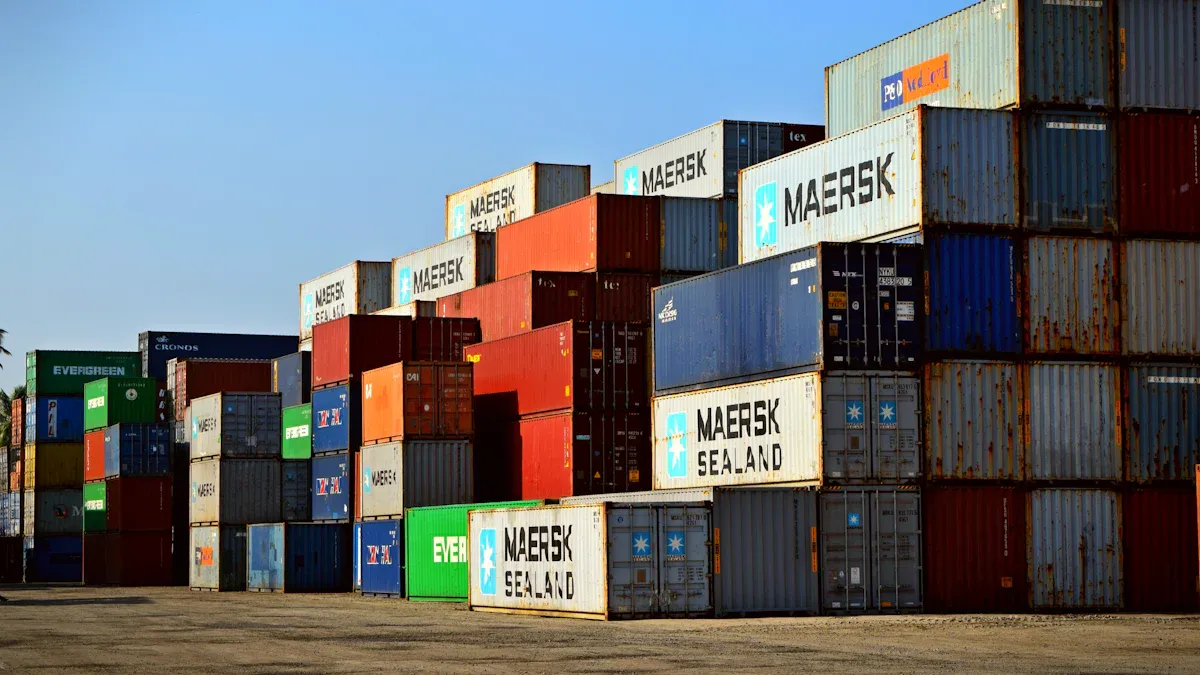Unlocking Growth with Supply Chain Management Outsourcing

Imagine your business slashing costs while gaining speed and expertise. Supply chain management outsourcing lets you do just that.
- Singing Machine Company saved $2.8 million a year by outsourcing logistics.
- Natural Dog Company cut $1.25 million in costs, including postage and payroll, through outsourcing.
You can focus on core competencies and let experts handle routine tasks. Outsourcing brings better strategy, risk management, and real-time collaboration. Many business leaders choose outsourcing to improve supply chain management, streamline operations, and boost sustainability. Unlock a strategic advantage and keep your business ahead.
What Is Supply Chain Management Outsourcing

Definition
You can think of supply chain management outsourcing as handing over your company’s supply chain operations to a third-party expert. Industry experts describe this as delegating tasks like logistics, procurement, inventory management, and distribution to a specialist. The main goal is to use the provider’s skills and resources to boost efficiency and let you focus on your core business.
Supply chain management outsourcing covers several key components:
- Planning: You decide where to produce, what to outsource, and how to measure performance.
- Sourcing: You manage buying raw materials, choosing suppliers, negotiating contracts, and making sure deliveries arrive on time.
Note: Most business process outsourcing in supply chain management happens during the sourcing phase, where you manage procurement and supplier relationships.
When you use outsourcing, you gain access to advanced logistics networks and technology that might be too costly to build in-house. This approach helps you streamline your business and improve efficiency.
Strategic Role
Outsourcing plays a major role in your business strategy. It lets you focus on what you do best while experts handle logistics and supply chain management. You can scale your operations quickly and respond to market changes without heavy investments.
A recent survey found that 94% of executives believe supply chain decisions shape business strategy. CEOs expect supply chain leaders to drive growth, not just cut costs. Outsourcing supports this by:
- Boosting efficiency and reducing costs through specialized providers.
- Giving you access to skills and technology you may not have internally.
- Allowing you to scale up or down based on demand.
- Helping you focus on your main business goals.
- Reducing risks and improving business continuity.
Outsourcing in supply chain management gives you a strategic edge. You can meet customer needs faster, adapt to new markets, and keep your business competitive.
Strategic Advantage of Outsourcing
Cost Savings
Outsourcing supply chain management gives your business a clear path to cost efficiency. You can reduce expenses by letting experts handle logistics, warehousing, and procurement. Many companies report significant savings after switching to business process outsourcing for their supply chain functions.
- Shared service centers can cut operational costs by up to 40% by removing duplicate processes.
- Procter & Gamble lowered logistics costs by 10–15% through supply chain realignment.
- Coca-Cola’s European division saved 20% on raw materials by restructuring supplier relationships.
- Outsourcing logistics to third-party providers can reduce supply chain costs by up to 25%.
- 86% of shippers say working with a third-party logistics provider helped them cut logistics expenses.
- Wyze reduced its full-time fulfillment staff by 50% after outsourcing logistics and automating order fulfillment.
You can see the difference in cost structure when you compare in-house logistics to outsourcing:
| Cost Component | In-House Logistics (Fixed Costs) | 3PL Provider (Variable Costs) |
|---|---|---|
| Warehousing | Rent, utilities, maintenance | Costs based on space used and services consumed |
| Transportation | Vehicle fleet ownership, maintenance, insurance | Costs based on shipping volume, distance, and carrier rates |
| Technology | High upfront investment in software and hardware | Access to shared platforms and economies of scale |
Outsourcing logistics processes such as transportation, warehousing, and inventory management brings the highest cost savings. You avoid large investments in technology and infrastructure. Third-party providers use advanced tools and economies of scale to deliver better operational efficiency. Contract manufacturing in countries with lower labor costs also helps you save on production expenses. By outsourcing procurement, you can improve raw material sourcing and reduce inventory needs.
Operational Agility
You need to respond quickly to market changes. Outsourcing gives your business the flexibility to scale operations up or down without delay. When you partner with supply chain management experts, you gain the ability to adapt to new demands, enter new markets, and manage risks more effectively.
Here are some real-world examples:
| Company/Industry | Challenge | Outsourcing Solution | Result Demonstrating Increased Flexibility |
|---|---|---|---|
| Construction Equipment OEM | Damaged products and poor presentation in filter kit packaging | Outsourced kitting to NewStream | Immediate improvement in quality and customer service, increased sales, zero errors (0 PPM) |
| Canadian Natural Gas Technology Manufacturer | Inefficient on-time delivery (65%) | Outsourced supply chain management to NewStream with customized kitting and packing | On-time delivery improved to 98% within 12 months, enabling focus on core manufacturing |
| Large On/Off Highway OEM (Government/Defense Contract) | Rapid program growth requiring scalable kitting and packaging | NewStream expanded operations by 200,000 sq ft and 200 personnel in 6 months | Maintained 100% on-time delivery, shipped 14,800 kits worth $80M, secured 7 contracts, showing operational flexibility and adaptability |
You can also outsource procurement to a partner with global expertise. This move lets you scale procurement activities without hiring more staff or investing in new systems. Your business can quickly adapt to changing market conditions, improve supplier management, and boost operational efficiency. Outsourcing technology services frees up resources so you can focus on core competencies and drive innovation. Many companies have used outsourcing to optimize supply chains, reduce lead times, and expand into new regions. These actions help you meet customer needs faster and improve customer satisfaction.
Access to Expertise
Outsourcing supply chain management connects you with specialized knowledge and advanced technology. Third-party logistics providers offer skills and resources that most in-house teams cannot match. You benefit from years of industry experience, regulatory know-how, and best practices.
- Third-party providers use real-time tracking and warehouse management systems.
- They implement sustainable logistics practices, such as eco-friendly packaging and optimized routing.
- Providers bring cost savings through economies of scale and specialized knowledge.
- You gain efficiency in inventory and transportation management.
- Providers offer scalability and flexibility to handle demand changes.
- You get enhanced control and visibility with innovative technology.
- Providers give you access to global networks, helping your business expand.
- They ensure security with strong data protection.
You also benefit from predictive analytics for demand forecasting, custom packaging, and temperature-controlled storage. Providers help you comply with complex regulations and offer value-added services like product assembly and subscription fulfillment. For example, Apple partners with Foxconn to leverage global supply chain expertise. This partnership allows Apple to focus on design and software while Foxconn manages high-volume production and logistics. The result is better operational efficiency, cost savings, and the ability to serve customers worldwide.
By outsourcing, you gain access to expertise, technology, and global networks. This strategic advantage helps your business streamline operations, reduce costs, and enhance customer satisfaction. You can focus on your main goals while experts handle the complexity of supply chain management.
Building Resilience in Supply Chain Management

Risk Management
You face constant challenges in managing disruptions across your supply chain. Building resilience starts with a strong risk management strategy. Outsourcing logistics can give you efficiency gains and access to external expertise, especially when you lack internal capabilities. However, you must recognize that outsourcing may reduce your control and visibility, making coordination harder during disruptions. Long-term contracts sometimes limit your flexibility to respond quickly in a crisis.
Tip: Carefully design outsourcing contracts to include flexibility and capacity provisions for rare but high-impact events.
You can use several risk management frameworks to strengthen your resilience:
- NIST Supply Chain Risk Management Framework
- Shared Assessments Third-Party Risk Management Framework
- ISO 31000 and COSO Enterprise Risk Management Framework
These frameworks help you address cybersecurity, third-party risk, and enterprise-wide risk management. You should select a framework that fits your industry and risk profile. Integrate risk assessment into supplier selection and contract management. Build a centralized supplier database to support visibility and reporting. Categorize suppliers by risk and conduct regular assessments to maintain resilience.
Organizations also use outsourcing as part of supplier diversification. By working with multiple suppliers, you reduce dependency on a single source and lower the risk of shortages. Building strong partnerships with suppliers improves communication and collaboration, which is critical when managing disruptions. Technology, such as real-time tracking systems, supports better supplier communication and early alerts about potential issues.
Flexibility and Scalability
You need flexibility to adapt to changing market demands. Outsourcing supply chain management to third-party logistics providers allows you to scale operations up or down as needed. These providers offer advanced data and technology, including predictive analytics and real-time tracking systems, to optimize logistics and inventory control.
- You avoid heavy investments in labor, equipment, and technology.
- Third-party providers use predictive analytics for demand forecasting and route optimization.
- Real-time tracking gives you visibility into shipments and inventory at every stage.
- You can quickly adjust to market volatility and meet customer needs without overextending resources.
Partnering with experienced logistics providers helps you focus on core business activities while maintaining resilience. You also support sustainability by using providers with eco-friendly practices. Tracking and analytics tools ensure you stay informed and ready to respond to disruptions. By building resilience through flexibility and scalability, you keep your supply chain strong and responsive.
Challenges and Best Practices
Common Risks
When you choose outsourcing for your supply chain, you face several risks that can impact your business.
- Financial risks include currency changes, cost increases, and even supplier bankruptcy.
- Geopolitical risks such as political instability or trade restrictions can disrupt your delivery schedules.
- Cultural risks may cause miscommunication due to different business practices or languages.
- Supply chain risks involve raw material shortages, transport delays, or over-dependence on a single supplier.
- Communication risks arise from time zone differences or unclear protocols, leading to misunderstandings.
- Compliance risks can result from not following legal or regulatory rules, which may damage your reputation.
- Quality risks appear when vendors deliver sub-standard products or services.
- Reputational risks occur if a vendor’s actions harm your brand image.
Tip: You can reduce these risks by doing financial checks, diversifying suppliers, setting clear quality standards, and using regular audits.
Integration Solutions
You may find it challenging to blend outsourced services with your existing systems.
- Resistance to change often comes from employees or suppliers who prefer old ways of working.
- Legacy systems may not work well with new technology, making data sharing hard.
- Departmental silos can block information flow and slow down business process outsourcing.
To overcome these barriers, follow these best practices:
- Set clear goals and expectations with your partners.
- Train outsourced teams on your company’s systems and communication style.
- Keep communication open and transparent.
- Use technology for real-time tracking and document management.
- Automate order-to-pay processes to boost efficiency.
- Build trust by understanding your partners’ motivations.
- Create flexible contracts to adapt to changing needs.
These steps help you support sustainable business practices and improve environmentally responsible practices across your supply chain.
Performance Monitoring
You need to track your outsourced partners to ensure they meet your standards.
- Use key performance indicators (KPIs) like inventory turnover, supply chain cycle time, and cost savings.
- Monitor customer satisfaction by checking on-time delivery and order accuracy.
- Track operational efficiency with order fulfillment rates and transportation use.
| KPI Name | Description | Why It Matters |
|---|---|---|
| Customer Order Cycle Time | Days from order to delivery | Shows how fast you serve customers |
| Supply Chain Cost as % of Sales | Supply chain costs compared to sales | Tracks cost control in outsourcing |
| Inventory Turnover | How quickly you sell and replace inventory | Reveals efficiency and supplier issues |
| Supplier Performance (SIFOT) | Percentage of complete, on-time deliveries | Measures reliability and accountability |
Regular feedback, open communication, and performance incentives help you maintain high customer satisfaction and loyalty. Monitoring also supports sustainability by encouraging partners to adopt environmentally responsible practices.
Supply chain management outsourcing gives your business flexibility, risk mitigation, and operational efficiency. You gain scalability, access to advanced technology, and improved customer satisfaction.
To balance these benefits, develop strong risk management plans and choose partners with proven expertise.
Consider these steps:
- Assess your current supply chain processes and set clear objectives.
- Involve key stakeholders and review technology needs.
- Consult experts to guide your business toward growth and resilience.
FAQ
What types of supply chain tasks can you outsource?
You can outsource logistics, procurement, inventory management, order fulfillment, and transportation.
Tip: Start with non-core tasks to test outsourcing before expanding to more complex operations.
How do you choose the right outsourcing partner?
Look for providers with industry experience, strong technology, and proven results.
- Check references
- Review case studies
- Evaluate communication skills
Will outsourcing affect your control over the supply chain?
You keep strategic control by setting clear goals and monitoring performance.
| Control Area | Your Role | Provider’s Role |
|---|---|---|
| Strategy | Set direction | Execute tasks |
| Reporting | Review results | Provide data |
How do you measure outsourcing success?
Track key performance indicators (KPIs) like cost savings, delivery speed, and customer satisfaction.
Regularly review these metrics to ensure your outsourcing partner meets your business goals.
See Also
Key Features That Make WarpDriven ERP Ideal For Smart Enterprises
Ways Top Companies Grow Using WarpDriven Distribution Solutions
The Role Of Distribution Management In Driving Worldwide Business
Important 2025 Amazon FBM Fee Updates Every Seller Should Know